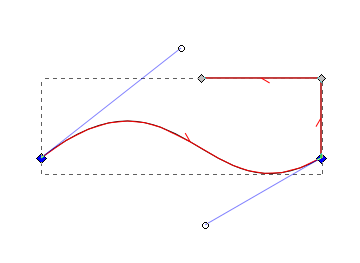hulf2012 wrote:Hello,
If you are more interested in drawing a tangent curve for the bulb in a less geometrical way, then I will write an example way for doing that.
Well, I think it's an interesting topic. I've managed to conect to circles with a tangen curve (the arc of another circle), but it's just for special cases. And other limitations.
Lazur, if you want please share that example. Later, I will try to show my method, but I can't promise it.
Greetings
Well I was afraid that this has to be explained haha.
Here is the process in a nutshell:

It is much harder to describe step by step for someone new to inkscape as it is only complicated without some routine in the basic tools.
The idea behind is that the circle arches are as well defined for a 45° turn by two nodes as this tangent curve should be.
So it is an intuitive representation of such tangent curve -as you couldn't be sure with any path's curves, what do they really represent.
Off topic:
This is my biggest problem with the whole svg specification, you cannot be sure even with a circle.
And, at least some indication should be added in the program in my opinion,
how the path turns -like in blender, you have the option to display the face's normals, and there is even some indication on curves.
I'm thinking of a way to display the line's radius/curvature along the path.
For an example, if you want to draw a nice "S" turn, it's a nightmare to set the path right,
as you cannot really now wether the node you put in the middle becomes an inflexion point or not.
druban wrote:Here is a topic that talks of tangent lines; tangent curves to two circles would necessarily be within the two tangent points of the line (for concave curves, naturally another set of convex tangent curves would be outside those points). You can control the slope/shape of the tangent line/curve, or the separation between the two circle centers or the relative sizes of the circles, but not all three! Also as Lazur has pointed out the tangent curve cannot ever be a circle
It can be a circle but not in this case.
You can construct a tangent circle to two given circles and one point, or to two circles and a line,
or a tangent circle to three circles.
That last one is the hardest of those, I should read them upon as inversion is used for the construction.
Well it's theoretical, knowing that it wouldn't come out precisely in inkscape. Maybe with python?...
The wikipedia has some nice examples for those:
 http://en.wikipedia.org/wiki/Apollonian_gasket
http://en.wikipedia.org/wiki/Apollonian_gasketDidn't checked that mentioned post, I will look at it!

 This is a read-only archive of the inkscapeforum.com site. You can search for info here or post new questions and comments at
This is a read-only archive of the inkscapeforum.com site. You can search for info here or post new questions and comments at 
